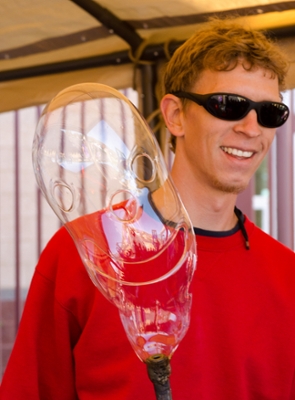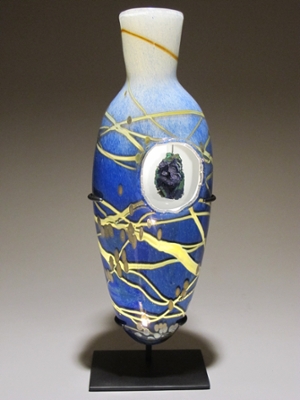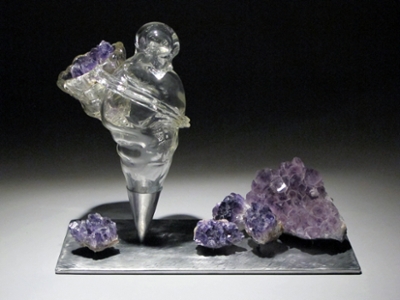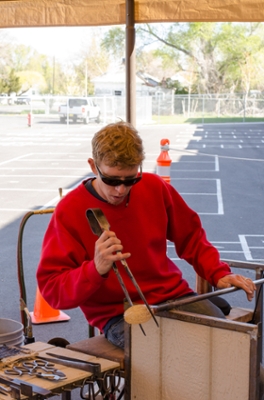STEM Career Profile: Adam Frus
October 29, 2015 -
This particular profile is not just STEM, but is a special “STEAM” approach (A = Art). Adam wanted us to expand the definition for this profile to highlight the multidisciplinary approach, which expanded the applications of core science knowledge and has allowed his STEM knowledge to help him look at the art processes differently. He is excited to be a part of this change!

A. Adam Frus, owner of Frus Glass, a glass blowing and mineral sales company
Q. What does your organization do?
A. I create fine art that bridges the gap between art and science. I do this by incorporating mineral specimens into my artwork or by decorating my pieces with geological themes such as cross sections and topographic lines. Most recently, I have been making a series that pays homage to chemistry and the minerals that are utilized to produce color in glass. I also sell mineral specimens on their own at various rock & gem shows, and I contract as an educator to give lectures to children and adults about the core concepts of geology, paleontology and the chemistry of glass.
Q. What do you do on a daily basis?
A. Outside of being a stay-at-home dad (4.5 year-old girl), I spend a lot of time designing work in my sketch book and formulating concepts on how to artistically integrate geologic principals into my art work. To do this I am constantly reading scientific papers and following the progress of those institutions that have active physical modelling laboratories (i.e. faulting experiments). Also, as an avid mineral collector I regularly go into the mountains for mineral digs. This passion has led me to become a member of the Albuquerque Gem & Mineral Club (AGMC) - an organization for which I serve as Secretary on the Board of Directors.
Q. What best part of your job?
A. Outside of actually selling work, it’s the many conversations that I get in with adults or, even better, high school students about to go into college. This is where I can show them the application of some of the science that I studied. Most often that comes into scientific literacy and having a baseline of knowing methods on how to do research through scientific literature and text books. For example, in order to decide what type of mineral specimen to use in my artwork, I will submerse myself in that mineral’s chemistry, its locality, and the geology of the surrounding area. Then I have to go through a similar process to make sure that there is a chemical similarity between the glass colors that I use and the mineral that I have chosen. The conversations that ensue are a good way to get people excited and interested in collegiate or continuing education programs in the sciences or in art.
The other thing I really like doing is public demonstrations. I own (and built from scratch) a mobile glass blowing studio that I can take on the road for special events. During demonstrations I create wonderful art in front of live audiences, but also, because of my scientific nature, I always include small tidbits of lecture about the glass chemistry or I do small demonstrations that explore the physical properties of glass; temperature dependent viscosity changes, material stress induced through cooling, the creation of fiber optics and even a bit about that thickened ridge that you may see around the top of a wine glass. Over the years, I have found that what I do with glass is limitless as long as I understand the parameters of the material that I work with.
Q. What degrees have you earned and from where?
A. I have a Bachelor’s of Science (2007) in Geology from Arizona State University
Q. When you were working towards your first degree, did you ever imagine that you would end up where you have?
A. Yes and no. I was introduced to glass right around the age of 16 (sophomore year) and it was that experience with molten glass that made me pursue geology, with an interest in volcanology specifically. When I graduated (undergrad), the competition in the field was very intense and I was already into the glass blowing at two local studios in Arizona. It was during that time that I first began to develop the concept of using my art to talk about the things I was learning at school. That made sense to me and it allowed me to take the role of an informal educator, a position that has always been in my line of sight.
Q. What took you from your first degree to the point you are now? In other words, what was your career path?
A. A major factor in my career path was support from my wife, Becky (we got married when we graduated). At that time, we decided that she would stay at ASU for a master’s in Geoscience Education and that I would continue trying to push into art since I had already started down that path. She is now a PhD candidate at the University of New Mexico in the geosciences and through it all, she has continued to push me to go in this direction as an artist. Her degree- and my involvement with it- keeps me invested in the field of geology. When she has field research to do, I often go along as a field assistant (our daughter does too). Inversely, when I turn on my glass studio for a four-day session, Becky often works with me as my glass assistant. We work really well together.
 Q. What were some of the significant challenges you encountered along the way?
Q. What were some of the significant challenges you encountered along the way?
A. One is how to communicate, to the public, the complex ideas and concepts of geology that inform my artwork without being too literal and keeping the “art” in it. It often needs a deeper conversation to express how they are connected and that is not always conducive to sales... unless we get the chance to talk about the work. Additionally, the integration of mineral specimens has been an uphill battle; to understand the chemistry behind it, but also how to treat the specimens as a mineral collector would, rather than degrading them for the art. What I represent in my work are collectible minerals, not broken chunks of them. That has led to its own challenges because art consumers don’t always want to purchase minerals, and vice-versa. On the other hand, everyone enjoys the conversations that ensue. The only other challenge that I face is being an artsy artist. I was into science first, which leads me to be analytical in my designs. My mentors have to remind me to put the “art” up-front and the science in-back, but I constantly struggle with the desire to do it in the opposite direction.
Q. How did you overcome these challenges?
A. The first is with perseverance. I am still in the process of building a niche for the glass and mineral combination. The second is that I listen to a lot of mentors in the art field to learn “the game” of galleries, sales techniques and about how to project that aura of an “ARTIST.” And third, I seek out scientists and geologists that do interesting things to make sure that I understand the chemistry or processes that they are working with. For example, I did some faulting experiments (sandbox models) that were produced in glass. Those objects were then taken to Karl Karlstrom at UNM to be fully interpreted so that each structure would be labeled properly.
Q. What would you say are the key milestones in your career pathway?
A. As an artist, the first major milestone was to become an Artist-In-Residence at the Mesa Arts Center in Arizona. That experience gave me time and resources to explore new techniques without the full monetary expense of studio ownership. Following that, I would include acceptance to galleries and a few awards at art shows.

As for incorporating STEM knowledge into the art, there are two major accomplishments that I can think of. The first is the creation of an award-winning display that I call “The Minerals of the Glass Industry.” It features examples of colored glass and the mineral specimens that serve as the primary ores of chemical elements that are used as colorants in the glass industry. It also features examples of naturally-formed glasses (fulgurites, obsidian and tektites) and the primary minerals that are used for the creation of Soda-Lime glass itself.
The second STEM accomplishment was being recognized by AGI (American Geosciences Institute) and being selected to produce a series of awards for their outgoing presidents. To this end, there was also an article in their publication, Earth Magazine about me and that process. I feel that this was a major recognition by the science community as a whole, which is just as important to me as an art collector purchasing something for their home. It lets me know that I am on the right path.
Q. What advice would you give to an undergraduate student in a STEM field?
A. First, I would say get involved with your professors, even professors that you are not taking classes from. It’s something I didn’t take advantage of as much as I wanted to during my undergraduate education. Find researchers that will give you a chance, even if that available position does not seem to “fit” directly into your perceived career path. Working directly with a mentor will make you apply all the concepts that you are learning in your classes and give you real world experience as well. Secondly, step back and recognize the beauty in what you are studying. If you see something amazing when you look to the horizon or down through a microscope, consider using that image for decoration or in some other way so that people who aren’t studying what you study can see it and ask a question. It is well known that any time you explain something to another individual, that you get a deeper understanding of it for yourself.
Q. Is there anything else you’d like to add that we haven’t addressed?
A. I would like to thank Gary Smith (UNM) for recommending my inclusion into these STEM Gateway Interviews.
Website – www.frusglass@gmail.com
City of Residence – Albuquerque
Email – frusglass@gmail.com
